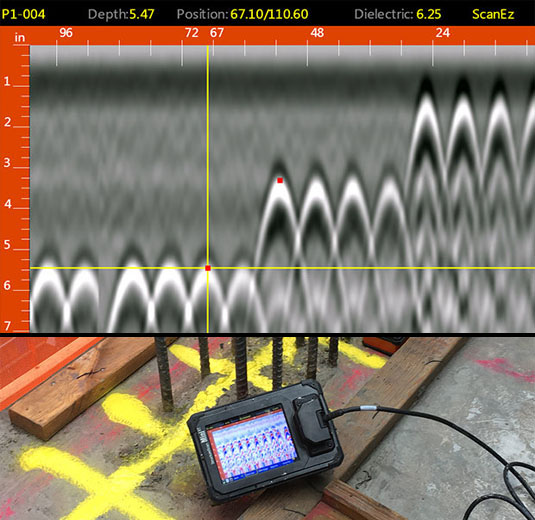Understanding RainierGPR Concrete Scanning: Crucial Idea
Understanding RainierGPR Concrete Scanning: Crucial Idea
Blog Article
Checking Out the Depths: A Comprehensive Guide to Concrete Scanning and Its Diverse Applications
In the realm of building and facilities growth, the thorough process of concrete scanning holds a pivotal role in making certain the architectural honesty and safety and security of jobs. As innovation remains to evolve, the applications of concrete scanning have actually broadened far beyond mere surface-level assessments. From finding rebar and post-tension cable televisions to drawing up voids and channels hidden within concrete frameworks, the abilities of contemporary scanning techniques are both essential and remarkable. The real deepness of concrete scanning's possible reaches also further, branching into unanticipated industries and triggering innovative options. The interconnected web of opportunities that concrete scanning provides is not just remarkable however additionally critical for the improvement of different markets.
Importance of Concrete Scanning
Comprehending the significance of concrete scanning is crucial in ensuring the security and honesty of structures during building and construction and remodelling tasks. Concrete scanning uses sophisticated modern technologies such as ground-penetrating radar (GPR) and electro-magnetic induction to detect ingrained things, gaps, or other abnormalities within concrete structures.
Moreover, concrete scanning plays a critical role in making sure compliance with building codes and policies that mandate the defense of existing structural components during construction activities. By properly mapping out the inner make-up of concrete, scanning technologies enable building experts to make educated choices that maintain the architectural stability and durability of buildings and framework tasks. Essentially, the value of concrete scanning exists in its ability to protect both the structural honesty and the workers involved in construction undertakings.
Technologies Made Use Of in Concrete Scanning
Concrete scanning relies on advanced technologies such as ground-penetrating radar (GPR) and electromagnetic induction to precisely find embedded items and anomalies within concrete structures. Ground-penetrating radar runs by discharging high-frequency electro-magnetic waves into the concrete.
Electromagnetic induction, on the various other hand, functions by generating electromagnetic fields around a concrete framework with a transmitter coil. When steel items are present within the concrete, they interfere with these electromagnetic areas, triggering eddy currents to stream via the steel. By determining the modifications in the magnetic fields with a receiver coil, the system can identify the location of metallic objects in the concrete.
These advanced innovations play an essential function in non-destructive testing, making sure the safety and honesty of concrete structures in numerous markets.
Applications in Building And Construction Market
Within the building market, concrete scanning modern technology locates varied applications that improve project efficiency and safety and security. One vital application is the detection of rebar, post-tension wires, and various other ingrained things prior to drilling or cutting into concrete frameworks. By accurately drawing up these elements, building teams can stay clear of pricey problems, make sure architectural honesty, and prevent prospective safety and security dangers. Furthermore, concrete scanning is used for situating voids, such as air pockets or locations of degeneration within concrete, which can compromise the overall stamina of a structure. By identifying these spaces early on, building and construction professionals can take required measures to address them and keep the durability of the building. Additionally, concrete scanning plays an essential role in quality assurance by validating the density of concrete covers over reinforcement, making sure conformity with layout specs and requirements. On the whole, the applications of concrete scanning in the building sector add dramatically to improving task operations, reducing threats, and providing top quality outcomes.

Safety Advantages of Concrete Scanning
In the realm of construction safety, the execution of concrete scanning technology presents a paramount advantage in preemptively recognizing prospective hazards and fortifying structural honesty. By making use of sophisticated scanning techniques such as ground-penetrating radar (GPR) and electromagnetic induction, building groups can properly locate rebar, post-tension wires, Full Article avenues, and other hidden things within concrete frameworks. This proactive technique significantly reduces the threat of unintentional strikes during drilling, cutting, or coring tasks, thus stopping costly problems, injuries, and job delays.
Additionally, concrete scanning enhances employee safety and security by supplying real-time info concerning the structural condition of concrete aspects. This data enables building specialists to examine the integrity of existing structures, determine degeneration or issues, and make educated choices concerning repair service and maintenance procedures. By dealing with possible safety problems without delay, concrete scanning contributes to producing a safe and secure functioning setting and mitigating the probability of structural failings or crashes on construction websites. Inevitably, the safety and security benefits of concrete scanning not just protect possessions and lives yet additionally maintain industry criteria for quality and dependability.
Future Patterns in Concrete Scanning
Emerging improvements in scanning innovation are positioned to change the field of concrete inspection and analysis. By harnessing the power of AI, these systems can assess vast quantities of data gathered throughout scanning processes to offer more accurate and detailed understandings right into the condition of concrete frameworks.
One more considerable trend is the development of more portable and easy to use scanning gadgets. Miniaturization of scanning equipment permits simpler access to restricted spaces and remote places, making examinations more reliable and thorough. In addition, innovations in wireless interaction technologies allow real-time information transfer and analysis, promoting quicker decision-making procedures.
Furthermore, there is a growing concentrate on sustainability in concrete scanning innovations - RainierGPR Concrete Scanning. Suppliers are significantly incorporating green products and energy-efficient features right into their gadgets to reduce environmental effect. These future trends are set to improve the efficiency, precision, and sustainability of concrete scanning practices, forming the industry's future landscape
Verdict
In final thought, concrete scanning plays an important role in the building and construction sector by guaranteeing the safety and security news and efficiency of various tasks. As modern technology advancements, the future of concrete scanning holds promising growths for boosting building procedures.

Report this page